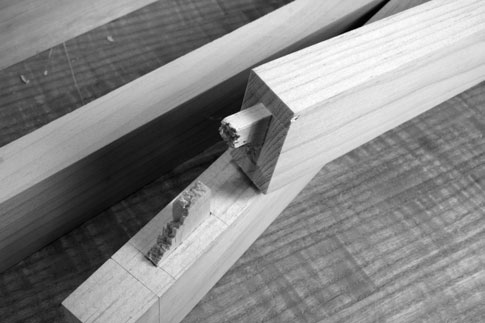
A couple years ago there was a kid in Iowa who was trying to learn to use hand tools. He had no teachers, just a few books and limited access to the Internet.
But he had a phone. So he’d call me and ask me questions for 30 minutes at a time. (Note to self: Get a 900-line for this. “Hey, I’m wearing a shop apron – and nothing else.”)
This kid’s first major crisis: Planing the top of a dresser. His iron was sharp. His plane was set correctly. His work was held firmly. Yet he couldn’t even get the tool to cut.
Diagnosis: Maple.
He was using rock maple as the wood for his first hand-tool project. I like maple and can get along with it fine. But it wouldn’t be my first pick for a wood to learn hand tools on.
I used to recommend walnut and poplar as good choices for beginning planers and sawyers. Both of those woods cut fairly easily with hand tools and aren’t stringy or hard or ring-porous or infused with silicates. (Ask me some time about the mouth-breather who insisted on using purpleheart on her first project, a birdhouse.)
This year, however, I have become smitten with Eastern white pine. It’s not common in the Midwest, but we came into a stash of it and I have been using it for everything possible. Unlike the yellow and white pine we get here, Eastern white cuts beautifully, planes easily and doesn’t seem as easy to mangle as the local stuff. Plus, the Eastern white moves less in service and (I think) it looks better.
On the downside, it’s quite lightweight and not nearly as strong as yellow pine or even the weirdo Swedish pine the local Borg is pushing.
But that, I figure, is just an engineering equation.
So this morning I’m building a complex frame-and-panel back for a five-drawer dresser. The back has six through-tenons, two blind ones and four floating panels.
I did a dry assembly of the stiles and rails right after lunch and everything looked nice and tight. So I took it apart to start fitting the panels when I snapped one of the tenons off like a Butterfinger bar.
I was too stunned to even curse. I don’t think I’ve ever snapped a tenon (by accident). The good news was that it was quick work to fetch a new piece and cut new tenons and mortises to replace the broken stick.
Note to self: Eastern white prefers 5/16”-thick tenons. But other than that, I think it’s the most hand-tool-friendly wood I’ve used.
— Christopher Schwarz